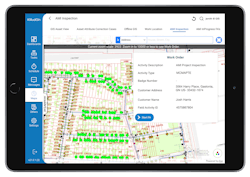Louisville Water Company began operations in 1860 as Kentucky’s first public water provider.
For the 161 years since, we have prided ourselves on delivering safe, high-quality water with unmatched value and service to our customers. Today, we cover more than 1,000 square miles in the Louisville Metro area and the surrounding counties, reaching one million people.
Technology and continuous innovation have always been a central element in helping the utility deliver on our brand promise. In 2018, the utility outlined a seven-year strategic plan to embrace technology to improve the customer experience, focus on new lines of business and regionalization, and expand partnerships on economic development. A core goal was enabling our workforce, which is key to our success. Our employees’ service makes it possible for the region to thrive and for customers to enjoy a quality product. To enable our employees to perform their best, we needed the best technology in place.
“This implementation was the largest technology project in Louisville Water’s history,” Louisville Water Executive Vice President of Customer Service Dave Vogel said. “Some of the immediate benefits included significantly cutting down our cancel/rebill process time and the ability to view all customer information within one screen with easily accessible drop-down and search menus. These simple benefits mean we can better serve our customers.”
This project was part of a larger, multiyear plan to modernize Louisville Water’s operations yet ensure the same level of reliability and quality our customers expect. With an eye on efficiency and service excellence, we sought to completely rethink our asset management program. Louisville Water manages assets across our portfolio that are worth $1 billion, and it’s essential to be able to know how each one is performing at all times. A failed asset means a customer may not be getting the water they need.
The key to this project was developing strong integration with our technology partners. Having worked closely with Oracle Utilities on our CIS project, we continued as an early adopter of a new version of the company’s Work and Asset Management (WAM) solution. This included weekly meetings with Oracle’s product teams and leadership to provide feedback on what innovations we needed and expected to see to make our project a success. During phase one of the project, the Oracle team adjusted to align with our project cadence to ensure we were getting the attention and support needed in an early adopter project.
Despite the challenges of the pandemic, we were able to go live with phase two on June 20, 2020. Today, we have a strong, data-driven asset program that allows us to forecast asset costs, perform predictive maintenance before failures occur, and ultimately extend the life of our assets. Central to the project’s success is the interoperability of data between our multiple systems, including our CIS and financial systems, advanced metering infrastructure platform, Environmental Systems Research Institute’s Geospatial Information System (GIS), and the KloudGin mobile workforce cloud solution.
By applying predictive indicators to this information, we can now anticipate our asset replacement needs, and reliably forecast maintenance costs. This includes whether it is more cost-effective to repair or replace an asset. The system also allows us to predict and mitigate failures before they occur to improve system reliability, reduce breakdowns, and even analyze asset energy usage across facilities to reduce costs.
Our new scheduling and field mobile solution, which replaced our old system in just 10 weeks, has also significantly improved our ability to respond to field incidents by enabling users to capture current valve status at the time of an incident. With data integration between our GIS, field service software, and work and asset management systems, we are able to now render data in a map view in near real-time to visually monitor the water distribution system’s current status and affected customers.
Also, it’s important for our field crews to have a GIS visual that is associated with the area that a worker is responsible for, including charts, graphs, and the ability to log photos. We know that information is critical for workers who return to the area. Our field resources also must have what’s needed to close out work with quality controls through surveys, photos, annotations, and notes. If a utility’s field resources aren’t working this way, then they’re probably going to encounter challenges.
Louisville Water is also able to leverage asset operational data to capture cathodic protection pipeline, rectifier, and test station readings. These readings are used to monitor the effectiveness of cathodic protection applications.
The new asset management system and our new mobile workforce application enable us to provide our employees with cross-application analytics that support process improvement, error prevention, and provide a better employee experience.
One of the goals of this project was to implement a single scheduling engine and mobile solution for both our linear assets, plants, and customer facing work — to ensure all of our resources were nimble enough to address emergency situations or resource constraints more efficiently. This wasn’t possible within our previously siloed mobile solutions.
“Our mission with this project was ‘doing the right thing, in the right place, at the right time,’ along with a goal of achieving operational efficiency,” Louisville Water’s Director of Infrastructure Planning and Records, James Bates said. “It’s not just about capturing work efficiencies but examining how we spend resources and replace assets that are at the end of their lifecycle. KloudGin mobile and WAM are providing us with crucial data, which has led us to greater operational efficiency and effectiveness.”
To date, we have achieved:
• Improved on-time arrival for customer appointments from 1 percent to 97 percent (despite a 226 percent increase in appointments made)
• Reduced manual data entry by 530 hours per month
• Increased work order throughput by 23 percent
Interestingly, one significant productivity improvement has been on the back-office side with timekeeping. We used to record time on paper, and a timekeeper would manually key it into our timekeeping application. Now our mobile workforce solution automatically captures time and integrates it into our timekeeping module. We estimate this has reduced back-office staff timekeeping duties by 75 percent.
At the outset of this project, our leadership team established several goals to tackle key business challenges, but we did not anticipate a year like 2020. With the added restrictions due to the global pandemic, our team took well deserved pride in completing this project on time and on budget.
We understood our goals and tracked them throughout the project. We also partnered with our vendors to ensure we were marching toward joint success. While participating in an early adopter program came with some bumps in the road, the end result was a project everyone could be proud of and will help us continue on our promise of ensuring our customers get the safe, high-quality water they deserve. WW
About the Author: Obe Everett is director of program management and business systems support at Louisville Water, where he currently directs and oversees Louisville Water portfolio of technical projects and business support activities, ensuring that programs and projects align with the goals set by the organization. With over 20 years of experience, Obe has a wealth of knowledge spanning credit/banking software development, wholesale product distribution, healthcare, and utility projects, all granting him a record of success and reliability. He has led implementation of technical solutions to over 200 service centers in North America and Europe, all with measurable business results.
About the Author
Obe Everett
Obe Everett is director of program management and business systems support at Louisville Water, where he currently directs and oversees Louisville Water portfolio of technical projects and business support activities, ensuring that programs and projects align with the goals set by the organization. With over 20 years of experience, Obe has a wealth of knowledge spanning credit/banking software development, wholesale product distribution, healthcare, and utility projects, all granting him a record of success and reliability. He has led implementation of technical solutions to over 200 service centers in North America and Europe, all with measurable business results.


